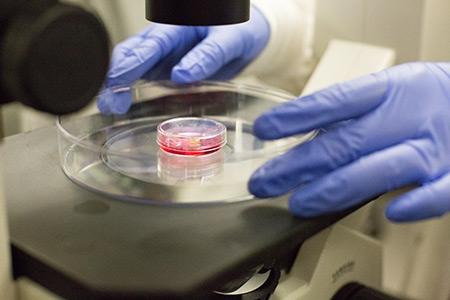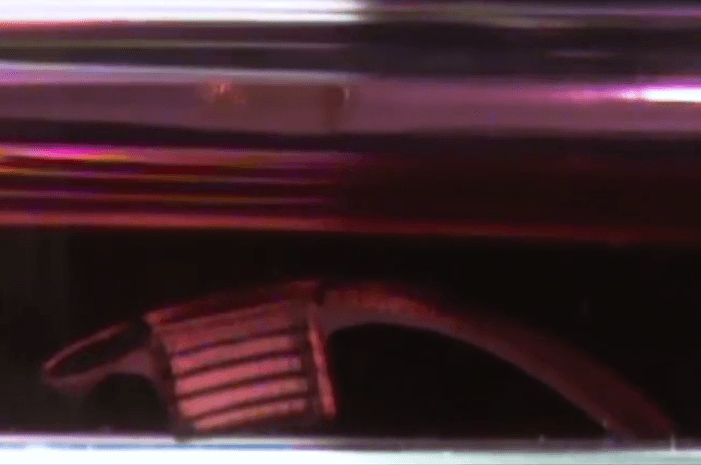 At the University of California Merced, the students in Professor Kara McCloskey’s class are building robots. That’s pretty neat, you may think, but not at all unusual – even elementary school kids are learning how to build robots these days, aren’t they? Not this kind of robots. McCloskey’s students are building bio-bots – tiny robots made from living tissue. They move, they walk, and they don’t have any electronic components – they have muscles.
At the University of California Merced, the students in Professor Kara McCloskey’s class are building robots. That’s pretty neat, you may think, but not at all unusual – even elementary school kids are learning how to build robots these days, aren’t they? Not this kind of robots. McCloskey’s students are building bio-bots – tiny robots made from living tissue. They move, they walk, and they don’t have any electronic components – they have muscles.
Freaky, right? What McCloskey’s students are doing is brand new, a type of technology that only began appearing in universities and research labs a few years ago.
“Bio-bots have only been around since 2012, so this is really cutting-edge science with multiple technologies — natural materials assembly, 3-D printing, genetic engineering, cell patterning and self-assembly, mechanical force generation – all in a micro-scale platform,” McCloskey said. “We are very excited to bring this amazing technology to the students. We’re working with the top engineering institutions in the country, with our students significantly benefiting from these collaborations.”
The work is being done as part of a $25 million Science and Technology Center (STC) grant from the National Science Foundation (NSF) – specifically, from the STC for Emergent Behaviors of Integrated Cellular Systems (EBICS), headquartered at MIT. The center was founded for the purpose of creating living, multicellular machines that can be used to solve problems in healthcare, security and the environment.
 In McCloskey’s lab, the students culture cells within a hydrogel, arranging them so that they grow into rings of muscle. The muscle is then attached to a 3D printed backbone. The muscles are responsive to blue light, which the students then shine on their creations to get them to contract, in effect exercising them to build contractile strength. The contraction of the muscles is what drives the movement of the bio-bots, or “walk-bots” as McCloskey’s students call them. You can watch the process in a video here.
In McCloskey’s lab, the students culture cells within a hydrogel, arranging them so that they grow into rings of muscle. The muscle is then attached to a 3D printed backbone. The muscles are responsive to blue light, which the students then shine on their creations to get them to contract, in effect exercising them to build contractile strength. The contraction of the muscles is what drives the movement of the bio-bots, or “walk-bots” as McCloskey’s students call them. You can watch the process in a video here.
By tweaking the design, engineers can customize the bio-bots for specific applications. McCloskey’s students are working on creating heart tissue, derived from stem cells, that could be used to patch human hearts that have been damaged by heart attacks. The patch of tissue would contract and expand in rhythm with the heartbeat. They’re not quite there yet, though, according to McCloskey – they haven’t yet come up with an effective way to integrate the contracting muscle with vasculature to supply blood.
The EBICS center is part of a large multi-university collaboration that involves UC Merced, MIT, the University of Georgia, the Georgia Institute of Technology, the University of Illinois at Urbana-Champaign (UIUC), the City College of New York, Morehouse College, Boston University, Gladstone Institutes, Princeton University, and Tufts University. The center focuses on research and education, as well as diversity and outreach programs and sharing knowledge.
UC Merced is only the second school to teach undergraduate students using the curriculum developed for the center by UIUC – the first was UIUC itself. The two schools are collaborating on the work, with NSF Research Fellow Rita Raman of UIUC helping to design and co-lecture the course that teaches students how to use 3D printers to design and build biological robots. UIUC, in addition to providing McCloskey with course protocol and lecture materials, also provided the molds for the muscle rings, the 3D printed skeletons and the stem cells.
According to Raman, the bio-bots are the best of both worlds – living creature and robot. They can be controlled like robots and targeted to the same types of applications, but their biological adaptive response behaviors could be harnessed for more complex functions like self-healing or self-assembly. While there’s a tremendous amount of potential for bio-bots in the future, the course is focused not on the applications, but on building a foundation for the technology by teaching students the fundamentals of designing and building with biological materials.
“We see many potential applications for bio-bots ranging from healthcare to national defense to environmental cleanup,” Raman said. “We want to introduce biological materials into the toolkit of the next generation of makers by giving them hands-on experience with bio-bot design and manufacture.”
Discuss in the Bio-Bots forum at 3DPB.com.
[Source/Images: UC Merced]
Subscribe to Our Email Newsletter
Stay up-to-date on all the latest news from the 3D printing industry and receive information and offers from third party vendors.
You May Also Like
Air Force Awards Fortius Metals $1.25M to Qualify 3D Printing Wire for Hypersonic Applications
AFWERX, part of the US Air Force Research Laboratory (AFRL), awarded a Direct-to-Phase II Small Business Innovation Research (SBIR) contract worth $1.25 million to Colorado’s Fortius Metals, to accelerate qualification...
US Air Force Awards JuggerBot $4M for Large-format Hybrid 3D Printing
Large-format 3D printer manufacturer JuggerBot has received a $4 million grant to develop a large format 3D printer, courtesy of the Under Secretary of Defense, Research and Engineering Manufacturing Technology...
Where Have All AM’s Unicorns Gone?
In the rapidly evolving world of 3D printing, startups valued at over a billion dollars, known as unicorns, once seemed as fantastical as the mythical creatures themselves. While a few...
How My Childhood Fascination with Planes Led to Investing in 3D Printing
My fascination with aerospace started young, and I started studying planes–identifying them in the sky and learning everything I could about how they work. Fast forward to my first week...

































